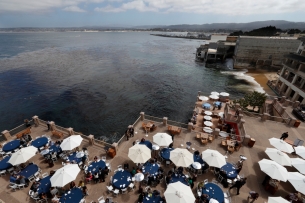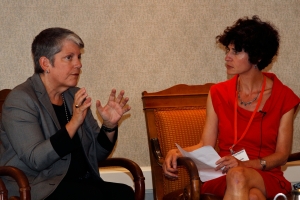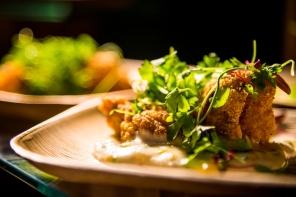
When the first groups of early humans stood up and foraged on the plains of East Africa, they solved their food shortages by walking somewhere new. In other words, Dr. M. Sanjayan said, “Humans were never sustainable in one place.”
Sanjayan, a scientist and member of Conservation International’s senior leadership team—whom you may have seen on nature shows like Big Blue Live and Earth: A New Wild—proposed this concept in a keynote address that kicked off the Aquarium’s 11th annual Sustainable Foods Institute in Monterey.
Within a few days’ walk, Sanjayan said, our early ancestors were able to find new, unexploited resources, which they would deplete over time, then migrate again.
Today, our planet has 7 billion human mouths to feed. And nearly every inch of inhabitable land is already spoken for. “To achieve sustainability, we have to innovate,” Sanjayan said. “And we only have a couple of generations to pull it off.”

Flipping the script
The Institute is a two-day, annual conference that connects presenters from a variety of disciplines—including science, business and food production—with food writers and environmental journalists from across the country.
This year, speakers included Sanjayan; photographer and documentary film director Louie Psihoyos (The Cove, Racing Extinction); and University of California President Janet Napolitano. Each brought unique perspectives on how our food production, and our food choices as consumers, affect the resources we depend on: clean air, rich soil and a healthy ocean.
The Institute aims to bring the challenges related to sustainable food, and innovative solutions, to the attention of journalists who communicate with and inspire wider audiences.

“It’s so important to change the conversation about food,” says Aquarium Communications Director Ken Peterson, who’s been spearheading the Institute since its start. “The way you change a conversation is to get new ideas out there. Here, we have a room full of storytellers, and we’re helping them make new connections with people who have new approaches and new ideas about food systems.”
This year’s Institute focused on three topics: sustainable food production, climate change and plastic pollution.
Food for the future
Growing populations worldwide are demanding more protein, both from land and sea. To meet this demand, more land is being devoted to raising animals and their feed, and more coastal areas are being transformed into seafood farms. But overfishing, pollution and habitat destruction have already reduced the productivity of both marine and terrestrial environments. How can we meet the needs of our growing population sustainably?

Presenters at the Institute discussed two strategies. First, chefs and consumers can reduce demand for animal protein by moving land-based meat away from the center of the plate. Vegetables, and even seafood, require a lot less fresh water, space and energy to produce.
Second, people are finding innovative ways to produce more food in smaller areas, with lower environmental impacts. For example, Jonathan Wolfson, co-founder and CEO of TerraVia, highlighted new efforts to feed farmed fish using omega-3 fatty acids derived from algae rather than from wild fish.
Climate and carbon
A diet of vegetables and seafood has a much lower carbon footprint than one that includes red meat. In other words, eating vegan, vegetarian or pescatarian can help slow the rate of global warming and ocean acidification.

“Climate change and ocean acidification are transforming the ocean faster than we can measure the change,” said Aquarium Executive Director Julie Packard during her opening remarks. “Together, they represent the greatest environmental challenges of our time.”
But changing what we eat won’t address the carbon already in our ocean and atmosphere, which is already causing global change and threatening international food security. To cope with these challenges, the Institute’s presenters explored how technology might help us creatively adapt to a changing climate.
Small plastic, big problem
When plastics enter the ocean, they break into smaller pieces over time—but they never go away. Instead, much of it enters the marine food web. And as we catch and eat seafood, the plastic cycle leads right back to our plates—often with higher concentrations of toxins absorbed along the way.

“We complain about litter on our streets and beaches, but how do we wrap our minds around the predictions that plastic debris will, by some estimates, outnumber fish in the ocean by mid-century?” Julie asked in her remarks.
“That’s pretty gross,” Ken says. “Who wants to be eating plastic in their fish?”
Ocean plastic pollution is a threat to human health, and reduces the world’s supply of healthy, wild fish that are also safe to eat. As scientists continue to research the extent of the problem, others—including experts at Monterey Bay Aquarium—are exploring solutions. Each of us can help keep plastic out of the ocean, and out of our seafood, by refusing single-use plastic items like straws and grocery bags, and by urging policy and market-based actions.
A turning tide
Sustainable seafood, climate change and plastic pollution are just a few of the challenges of feeding a growing human population. Through the Sustainable Foods Institute, the Aquarium has convened some of the top minds working for a sustainable food supply. And they don’t have to do it alone.

“Every time we make a decision about what we’re eating,” Ken says, “we’re affecting the purity of the water, the health of the ocean, the productivity of the land, the survival of the wild species that depend on those resources, and our own survival.”
In a very real way, the path to food sustainability lies in the day-to-day decisions of ordinary people.
Featured image: Participants in the 2016 Sustainable Foods Institute enjoy lunch on the deck of Monterey Plaza Hotel.

Reblogged this on Diana LaScala-Gruenewald.
LikeLike